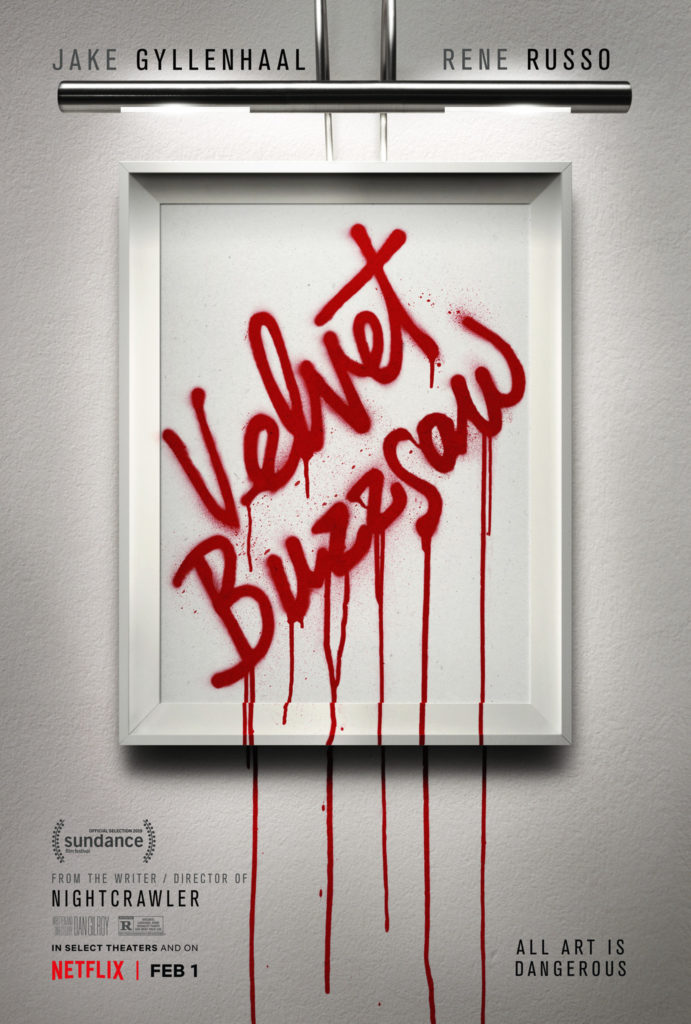Velvet Buzzsaw: Articulating the Irony of Art
Contains Spoilers
By its very nature, art remains a highly subjective concept that appeals to many. Less than three weeks ago, Netflix released an original film that ties into not just the subjectivity of art but also the underlying forces that drive a human being to live.
Categorized as a satire and pertaining to the profit-driven lives of Los Angeles’ elite art critics, “Velvet Buzzsaw” was an undeniably unique film to watch and an even more tricky piece to comprehend. Various characters, symbols, and underlying themes melded together to create what is Netflix’s newest masterpiece— one that is sure to keep you on the edge of your seat while simultaneously making you reflect on human nature.
Having no real previous experience in comprehending the meaning or purpose of art beyond a basic art history class taken in high school, I was eager to see how art and its purpose could be so vividly depicted in a dramatic thriller-like film. Right off the bat, the stereotypical art enthusiast was portrayed within the setting of a prominent Miami Beach art show.
Morf, played by star Jake Gyllenhaal, caught my attention with his position as an elite art reviewer and somewhat of a perfectionist. The satirical nature of the film was apparent from the first scene as upbeat music highlighted the pretentious nature of the art critics. I found it comical but mind-boggling at the same time; the very premise of art remains subjective to the viewer, so how are people profiting off such a concept through pretentious art shows?
I was intrigued but felt misinformed as I continued to watch more unique characters introduced into the plot. Here I was, expecting a traditional horror film with jump scares and chainsaws—I wasn’t entirely off in my expectations regarding the saw, but I was in for something a little more moving than I had anticipated.
Moving right along into the thick of the plot, a tragedy occurs early on that shapes the entirety of the film. After the death of mysterious and somewhat eerie neighbor and talented artist Ventril Dease, the unnerving nature of the film begins to shine through. Josephina, portrayed by Zawe Ashton, begins to steal the pieces of art that were explicitly marked to be discarded. As she steals every work she can get her hands on, the greedy nature of each and every art critic shines through. It becomes clear that every character has only one goal in mind: money.
The plot continued to progress within the film’s two-hour runtime and with it came the start of the action-packed, gory scenes I had anticipated. About midway through, I began to understand why the film was categorized within the thriller and horror genre as character after character met unique but similarly gruesome fates.
From rival art dealer Jon Dondon mysteriously being hung to Bryson— the gallery worker and aspiring elite artist—being literally pulled into a painting by raging monkeys, the deaths did not slow. Even protagonists Morf and Josephina face unpleasant endings as a result of their own greed. Through intricately detailed art pieces, the film incorporated high-tech effects to display underlying themes. And whether it be a killing robot machine or morphing into a piece of artwork itself, every character faced a similar fate and died in distinctive ways.
One of the most interesting aspects of the film and underlying themes revolves around the narcissistic nature of each and every character. As person after person within the small-scale art world continues to die after somehow connecting with the haunted paintings, the remaining characters appear impacted by the deaths of close “friends” for a fleeting moment. As soon as they learn of the potential profit of the same pieces that correspond with the deaths, however, they quickly gather themselves and prioritize what they deem important— profiting from the artwork.
In the notable and iconic ending of the satire, Rhodora—Josephina’s boss and the leader behind the entire scandal—meets the same fate as her Counterparts. As her tattoo of a buzzsaw from her own former band vividly comes to life and kills her, it appears as though the epic story has come to an end.
Not so fast, though—the Dease paintings aren’t quick to disappear. The film ends as an unknowing couple buys a piece of Dease art off the street, struck by its beauty. It became clear to me that the influence of the paintings never really ends—that is, until a sequel is made.
Nicole may be reached at
ngolba@su-spectator.com


